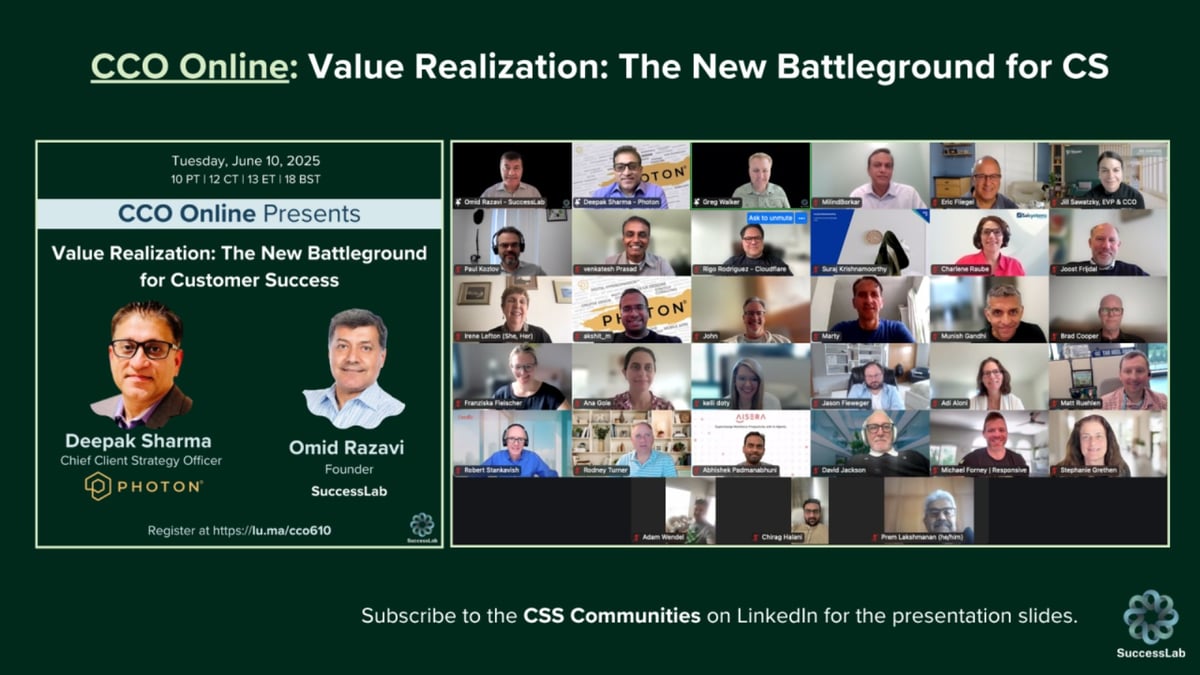Value Realization: The New Battleground for Customer Success

Omid Razavi
June 16, 2025
By Omid Razavi | Guest Speaker: Deepak Sharma, Chief Client Strategy Officer at Photon | CCO Online Series | June 10, 2025
Customer success leaders joined a thought-provoking session of CCO Online, featuring Deepak Sharma. Chief Client Strategy Officer at Photon, co-hosted by Gregory Walker, the session drew on Deepak’s deep experience at Photon, Deloitte, and IBM. His message? Value realization is rapidly becoming the new frontier, and imperative, for Customer Success (CS) teams.
This was more than a presentation; it was a masterclass in redefining customer success through measurable business outcomes, beyond just tracking retention.
The Shift: From Revenue Retention to Real Results
Customer Success is at a turning point. Historically, CS teams have focused on metrics such as renewals, product adoption, and upselling. These measures, while helpful, are no longer sufficient. According to Sharma, the modern customer expects more.
“Revenue-focused CS has taken us far, but not far enough,” Sharma explained. “If we can’t prove value, we risk becoming irrelevant.”
Customers today want a clear, measurable business impact. They expect vendors to demonstrate how a product or service contributes to their goals, whether that’s increasing revenue, lowering costs, or improving employee satisfaction.
The Core Framework: The Dual-Sided Value Scorecard
At the center of Sharma’s strategy is the Value Scorecard. This tool views customer relationships as a two-way exchange of value.
On one side, the scorecard measures the value delivered to the customer across three dimensions:
- Business Value: Tangible results, such as improved revenue or reduced costs.
- Experience Value: Satisfaction metrics, including CSAT, NPS, and customer effort score.
- Performance Value: Product performance indicators include uptime, implementation speed, and support responsiveness.
On the other side, the scorecard measures the value received by the provider. These include:
- Economic Value: Metrics like Annual Recurring Revenue (ARR) and Net Revenue Retention (NRR).
- Portfolio Expansion: The extent of cross-selling and upselling within an account.
- Customer Advocacy: References, testimonials, and word-of-mouth influence.
This dual-sided value scorecard serves as a strategic instrument that guides customer engagements, aligns internal teams, and sets the tone for quarterly business reviews (QBRs).
“Know Me, Enable Me, Empower Me”: Value Across the Journey
Sharma encouraged attendees to focus on the entire customer lifecycle, from Awareness to Advocacy. He outlined six key moments of value, focusing on three pivotal stages:
- Onboarding: Understanding user intent and ensuring smooth implementation.
- Adoption: Providing support and resources tailored to real customer needs.
- Advocacy: Empowering satisfied customers to promote your product or service.
These are not isolated events. They are interconnected experiences that must be thoughtfully designed and consistently measured.
Collaboration is Essential
A central theme of the session was the alignment of cross-functional teams. Sharma stressed that Customer Success cannot work in isolation. Instead, CS, Sales, and Product must collaborate around a shared mission.
“You need a common North Star,” Sharma said. “That means not just collaborating, but co-owning the outcomes.”
He described successful examples where cross-functional teams used joint success pods, shared scorecards, and feedback loops to build alignment and mutual accountability.
AI, Automation, and the Path to Scale
Sharma acknowledged that many elements of value realization—especially customer-specific business value—are still difficult to automate. However, AI and automation tools are rapidly changing that landscape.
His team at Photon uses a combination of Salesforce, Power BI, customer feedback, and internal systems to create a semi-automated view of both customer value and company performance. As GenAI tools become more sophisticated, Sharma believes these systems can scale beyond top-tier accounts and be applied across the broader customer base.
Case Studies: Putting the Strategy into Practice
Sharma shared real-world case studies to demonstrate how these principles translate into business results:
- A CRM platform reduced onboarding complexity by focusing on five core features, improving time-to-value by 50%.
- A visual design company created guided user journeys, resulting in a 10% increase in product activation.
- A digital learning platform streamlined efforts across nine customer segments, improving process efficiency.
- A video messaging company centralized onboarding tools and enabled internal champions, resulting in faster deployment and more user engagement.
Each case revealed a unique way to deliver value, showing that success depends on tailoring your approach to your product, customer base, and internal structure.
The Role of the CS Leader: Orchestrating Outcomes
In closing, Sharma offered a powerful reminder. If CS does not take responsibility for delivering and demonstrating customer value, no one else will.
“No one else in the company wakes up every day to maximize customer value—not Sales, not Finance, not Services,” he said. “If CS doesn’t own this, no one will.”
He urged CS leaders to stop fighting for territory and instead take on the role of orchestrator—bringing together people, tools, and insights to drive meaningful, measurable outcomes for both the company and the customer.
My Reflections and Insights
During the session, I shared my take on how CS has evolved from high-touch relationship management to a more data-driven, outcome-focused discipline.
“We’ve tried high touch, we’ve tried data-driven, and we’ve even flirted with revenue ownership,” I said. “But the thread that ties it all together is clear value for both the customer and our organization.”
In today’s crowded SaaS domain, earning customer mindshare is more complicated than ever. To stand out, CS teams must prove their impact early and often. That takes more than manual effort—it requires innovative, automated systems that help scale meaningful engagement.
“Digital CS and GenAI don’t replace empathy—they amplify it,” I explained. “They free us up to focus on what moves the needle.”
Sharma’s Value Scorecard struck me as one of the best tools I’ve seen for aligning teams and creating real accountability. It drives clarity, builds internal trust, and keeps everyone focused on outcomes.
The message to CS leaders is clear: it’s time to broaden your influence. Customer Success should have a seat at the table for product strategy, sales plays, and even boardroom discussions. However, to get there, value realization must evolve into a company-wide mindset, not just a CS initiative.
We then opened the session to audience questions, and the engagement from the CCO Online community was exceptional. Participants came ready with thoughtful questions that extended the conversation and grounded the ideas in real-world practice.
Q1: “When you talk about business outcomes, are you referring to specific KPIs? How do you measure those for the customer?”
Deepak Sharma: Yes, we’re talking about KPIs that matter to the customer, but not hundreds. Just one to three agreed-upon metrics that the customer believes your product or service can truly impact. These must be co-owned and co-measured. That’s why we only apply this to our top 15 clients. Automating this process for the long tail remains a challenge, but AI may help us overcome it.
Q2: “What goes into your monthly business outcome reports?”
Deepak Sharma: We report on the agreed metrics, whether good or bad. The customer needs to accept that causality isn't always direct. For instance, if their marketing team messes up and mobile app conversion drops, I’ll take the hit. If their campaign succeeds and lifts conversions, I benefit. That’s why a human QBR is so essential—to align on reality, not just numbers.
Q3: “How can we as CS leaders educate the rest of the C-suite—especially Sales, Product, and Finance—on the importance of value realization?”
Deepak Sharma: We have to create what I call “urban legends.” You need to combine correlation with real stories to make value tangible in the boardroom. I once had a CEO realize on his own that nobody in the organization was responsible for customer value. Another time, a CCO heard a customer say, “You delivered on time, but the experience was so bad we’re replacing you.” That became a legend at that company. So—pick a North Star, stick to your scorecard, and tell the stories that matter.
Q4: “Is part of the challenge that Customer Success is seen as a department, not a company-wide mindset?”
Deepak Sharma: Absolutely. That’s why I don’t call it Customer Success—I call it Client Outcomes. CS as a term often implies a narrow function. What we’re building is a cross-functional capability that orchestrates success. And it’s not about owning things—it’s about collaborating, enabling, and proving value both to customers and internal teams. Our peers—Sales, Product, and Support—are also our internal customers, and we must demonstrate the value we add to them.
Q5: “You said every problem will be an agent problem in the AI era. Can you explain what you mean by that?”
Deepak Sharma: The idea is that almost any business process can be transformed into an AI agent today. Whether it's viable or valuable is another question, but the feasibility is there. For example, if I want to automate a vacation booking, I could have a super agent that orchestrates sub-agents for flights, hotels, Airbnb, etc. Eventually, we'll see a world where more and more of our problems can be solved through intelligent, task-specific agents.
Final Thoughts: The Time is Now
This CCO Online session was more than a professional exchange—it was a call to action. CS leaders must redefine their purpose, reassert their strategic importance, and rebuild trust by delivering proven value.
Value management isn't a team function; it’s the operating system for sustainable growth. As Deepak Sharma warned, “If you don't define and prove the value you deliver, your competitor probably will.”
Join the CCO Communities to access the presentation slides and stay part of the ongoing conversation.
Like
Comments (0)
Popular
Dive in
Related
Blog
It’s Time to End the Confusion: Split Customer Success into Product Success and Account Management
Mar 9th, 2025 • Views 0
Blog
Mastering Monetized Customer Success: Strategies for SaaS Growth and Profitability
Feb 17th, 2023 • Views 0
Blog
Listen, Predict, Compose, Act – The AI Superpowers Reinventing Customer Success
Apr 18th, 2025 • Views 0
Blog
Mastering Monetized Customer Success: Strategies for SaaS Growth and Profitability
Feb 17th, 2023 • Views 0
Blog
Listen, Predict, Compose, Act – The AI Superpowers Reinventing Customer Success
Apr 18th, 2025 • Views 0
Blog
It’s Time to End the Confusion: Split Customer Success into Product Success and Account Management
Mar 9th, 2025 • Views 0

